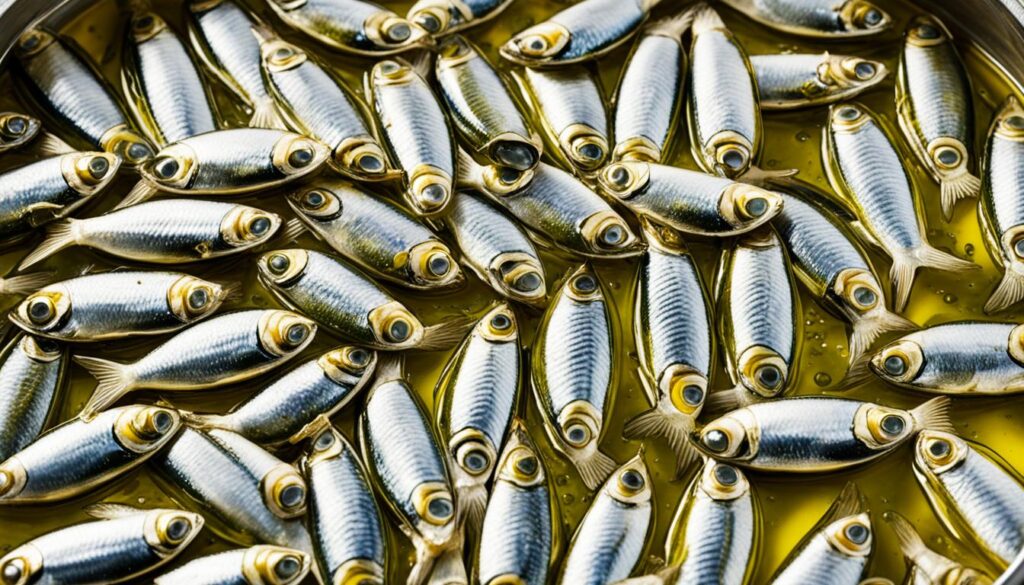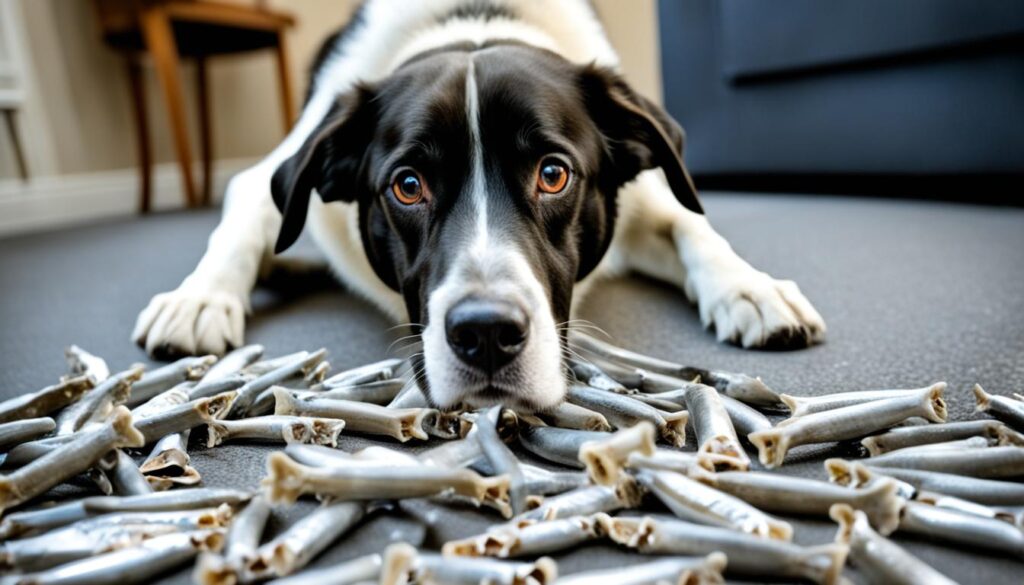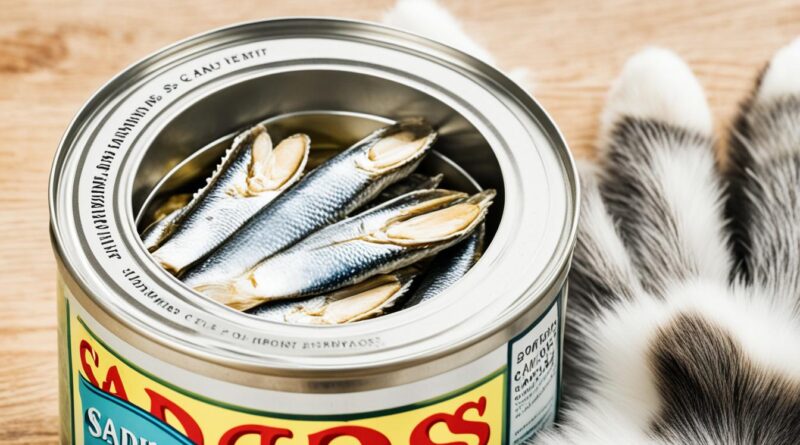Can Dogs Eat Sardines in Olive Oil? Find Out!
When it comes to dog nutrition, many owners are curious about what human foods are safe for their furry friends. One question that often arises is whether dogs can eat sardines in olive oil. Sardines are a type of small, oily fish that offer various health benefits for humans, but are they suitable for dogs as well?
Sardines are packed with protein, omega-3 fatty acids, vitamins, and minerals, making them a nutritious option for dogs. However, there are important considerations to keep in mind before incorporating sardines into your dog’s diet.
Key Takeaways:
- Feeding sardines to dogs can provide essential nutrients and omega-3 fatty acids.
- Sardines are a good source of protein, vitamins, and minerals.
- Dogs with certain health conditions may need to avoid sardines due to their high-fat content.
- It is not recommended to feed dogs sardines in olive oil.
- Remove all bones from sardines before feeding them to your dog.
Are Sardines Good For Dogs?
Sardines have numerous benefits when included in a dog’s diet. They are not only a delicious treat but also pack a nutritional punch. Sardines are an excellent source of protein, which is essential for maintaining and repairing tissues in a dog’s body. Additionally, they are rich in omega-3 fatty acids, specifically EPA (eicosapentaenoic acid) and DHA (docosahexaenoic acid), which offer various health benefits to dogs.
The omega-3 fatty acids found in sardines have anti-inflammatory properties that can help reduce joint inflammation and promote healthy skin and coat. They are particularly beneficial for dogs with arthritis or allergies. Omega-3 fatty acids also support cardiovascular health, brain function, and a strong immune system in dogs.
Sardines are also packed with essential vitamins and minerals that contribute to a dog’s overall well-being. They are a great source of Vitamin B12, which is necessary for the formation of red blood cells and proper neurological function. Additionally, sardines contain Vitamin D, which aids in calcium absorption and supports bone health. The fish are also rich in calcium and selenium, important minerals for a dog’s health and vitality.
By incorporating sardines into your dog’s diet, you provide them with a source of high-quality protein, essential fatty acids, vitamins, and minerals that contribute to their overall nutrition and well-being.
The Nutrition Profile of Sardines for Dogs
| Nutrient | Amount per 100g |
|---|---|
| Protein | 20.4g |
| Omega-3 Fatty Acids | EPA: 1.9g DHA: 1.5g |
| Vitamin B12 | 8.9μg |
| Vitamin D | 16 IU |
| Calcium | 382mg |
| Selenium | 45.2μg |
“Including sardines in your dog’s diet can provide them with a wide range of nutritional benefits, including protein, omega-3 fatty acids, vitamins, and minerals.”
Remember, moderation is key when feeding sardines to your dog. It’s important to consult with your veterinarian to determine the appropriate amount based on your dog’s size, breed, and overall health. Additionally, always choose sardines packed in water rather than those in oil or other additives. Remove any bones before feeding them to ensure the safety of your furry friend.
In the next section, we will discuss the safety considerations that come with feeding sardines to dogs and address the potential risks associated with their consumption.
Are Sardines Safe for Dogs?
While sardines are generally safe for dogs to consume, it’s important to be aware of certain concerns and risks associated with feeding sardines to dogs. Dogs with specific medical conditions should exercise caution when consuming sardines due to their high fat content. Conditions such as diabetes, obesity, pancreatitis, or kidney disease may require dogs to avoid sardines altogether.
Additionally, it’s essential to consider the substance in which the sardines are packed. Sardines in olive oil, for example, can contribute to weight gain and other health issues in dogs. It is not recommended to feed dogs sardines packed in olive oil. Instead, opt for sardines packed in water, as this helps to reduce the overall fat content.
Another consideration when feeding sardines to dogs is the presence of bones. While sardines are small fish and often come with edible soft bones, these bones can pose a risk of stomach irritation or intestinal puncture if ingested by dogs. To ensure the safety of your furry friend, it is best to remove all bones before feeding sardines to them.
Lastly, there is a concern regarding the risk of mercury poisoning in fish. Since sardines are a type of fish, it’s important to note that they may contain trace amounts of mercury. While sardines are generally considered low in mercury, it’s still advisable to moderate the amount of sardines fed to dogs, especially for smaller breeds.
In summary, while sardines can be a nutritious addition to a dog’s diet, it is crucial to consider the individual health needs of your pet before incorporating sardines into their meals. Remember to choose sardines packed in water, remove any bones, and monitor your dog’s overall well-being and weight. Consulting with a veterinarian can provide further guidance on safely including sardines in your dog’s nutritional plan.
Summary of Risks in Feeding Sardines to Dogs:
| Risks | Precautions |
|---|---|
| High fat content | Be cautious for dogs with diabetes, obesity, pancreatitis, or kidney disease |
| Sardines packed in olive oil | Avoid feeding dogs sardines packed in olive oil; choose water-packed sardines instead |
| Bone ingestion risk | Remove all bones before feeding sardines to dogs |
| Potential mercury poisoning | Moderate the amount of sardines fed, particularly for smaller dog breeds |
Can Dogs Eat Sardines in Olive Oil?
When it comes to feeding sardines to dogs, it’s important to consider the type of packaging they come in. While sardines packed in olive oil may seem like a palatable option, it’s not recommended for canine consumption. The additional fat from the olive oil can lead to weight gain and other potential health issues for dogs.
Instead, it’s best to choose sardines that are packed in water for your furry friend. By opting for water-packed sardines, you can provide the nutritional benefits without the excessive fat content. However, if you do have sardines in olive oil, there is a way to make them suitable for your dog’s consumption.
Here’s how:
- First, make sure to drain the excess oil from the sardines. This can be done by placing the fish pieces on a paper towel and gently patting them to remove the oil.
- Once the excess oil has been removed, the sardines can be fed to your dog. However, it’s important to monitor their intake and ensure it remains in moderation.
By following these simple steps, you can safely feed sardines to your dog while minimizing the potential health concerns associated with olive oil. Remember, dogs can still enjoy the nutritional benefits of sardines, but it’s crucial to make informed choices when it comes to the packaging and preparation.

“Feeding sardines packed in olive oil to dogs may lead to weight gain and other health issues due to the additional fat content.”
Can Dogs Eat Sardines With Bones?
Sardines may come with small bones inside the fish pieces, which can pose a risk of stomach irritation or intestinal puncture if ingested by dogs. To be safe, it is recommended to remove all bones before feeding sardines to your dog.
When feeding sardines to your dog, it’s important to be cautious about the presence of bones. Dogs may accidentally swallow these bones, leading to potential health issues. A bone may cause stomach irritation, blockages, or even puncture the intestines, requiring immediate veterinary attention.
Risks of Feeding Sardines With Bones to Dogs
“Feeding sardines with bones to dogs can result in gastrointestinal distress and potential harm. The bones can cause irritation, obstruction, or internal injury, leading to severe health consequences,” warns Dr. Samantha Johnson, a veterinarian at Pet Care Clinic.
While dogs have a natural instinct to gnaw and chew on bones, it is better to be cautious when it comes to sardine bones. To avoid any potential risks, it is best to remove all bones before feeding sardines to your furry friend.
Tips for Removing Bones from Sardines
- Inspect each sardine carefully to identify any visible bones.
- Use tweezers or your fingers to gently remove the bones from the fish.
- Ensure that all bones, including tiny ones, are completely removed.
By taking the time to remove bones from sardines, you can enjoy feeding this nutritious fish to your dog without worrying about potential hazards. Your dog can still benefit from the protein, omega-3 fatty acids, and other valuable nutrients found in sardines, while minimizing the risks associated with bones.
Remember, your dog’s safety is of utmost importance, and it’s always better to err on the side of caution when it comes to feeding them any food with potential risks.
| Benefits of Removing Bones from Sardines | Risks of Feeding Sardines with Bones |
|---|---|
|
|
Removing bones from sardines is a small step that can have a significant impact on your dog’s safety and well-being. This extra precaution will allow you to continue incorporating sardines into your dog’s diet as a healthy and nutritious addition.

Risks of Feeding Dogs Sardines
Feeding sardines to dogs can pose certain risks due to their high-fat content. While sardines are rich in omega-3 fatty acids and other beneficial nutrients, they can also lead to health issues for dogs, especially those that are already overweight, have sensitive stomachs, or are prone to certain medical conditions.
The high-fat content in sardines can contribute to weight gain and obesity in dogs. Excessive fat intake can disrupt their nutritional balance, which may lead to various health problems such as arthritis, diabetes, and pancreatitis. Additionally, dogs with sensitive stomachs may experience digestive issues like vomiting and diarrhea when consuming high-fat foods like sardines.
It is crucial for dog owners to pay close attention to their pet’s weight and monitor their response to the inclusion of sardines in their diet. Adjusting the amount of sardines fed can help mitigate the risks associated with high-fat food consumption.
If you suspect that your dog may be overweight or have underlying health concerns, it is always best to consult with a veterinarian before incorporating sardines or any new food into their diet. Your vet can offer personalized guidance and recommendations based on your furry friend’s specific needs.
“Feeding sardines to dogs requires careful consideration of their individual health and dietary requirements. While sardines can provide nutritional benefits, it’s essential to be mindful of the potential risks associated with their high-fat content.”
| Risks of Feeding Sardines to Dogs | Precautions |
|---|---|
| 1. Weight gain and obesity | Monitor your dog’s weight and adjust the amount of sardines fed accordingly. |
| 2. Digestive issues | Be aware of any vomiting or diarrhea and consult with a veterinarian if necessary. |
| 3. Increased risk of arthritis | Consider alternative dog-friendly fish options with lower fat content. |
| 4. Potential for diabetes | Limit high-fat food consumption and focus on a balanced diet. |
| 5. Risk of pancreatitis | Avoid feeding sardines to dogs with a history or predisposition to pancreatitis. |
Conclusion
Sardines can serve as a valuable addition to your dog’s nutrition when incorporated into their diet in moderation and with proper precautions. These small fish are packed with essential nutrients and omega-3 fatty acids, which play a vital role in supporting your dog’s overall health.
However, before introducing sardines into your dog’s diet, it is crucial to consider their individual health needs and seek guidance from a veterinarian. This step ensures that sardines align with your dog’s specific dietary requirements and any existing medical conditions.
When feeding sardines to your dog, remember to remove any bones to prevent the risk of stomach irritation or intestinal puncture. Opt for sardines packed in water rather than those packed in olive oil, as the additional fat in the oil can contribute to weight gain and other potential health issues.
It is always important to monitor your dog’s weight and response to the new food. By following these guidelines, you can safely incorporate sardines into your dog’s diet, providing them with the nutritional benefits they offer while ensuring their overall well-being.
FAQ
Can dogs eat sardines in olive oil?
It is not recommended to feed dogs sardines packed in olive oil. Olive oil adds additional fat to the already high-fat food and may lead to weight gain and other health issues. It’s best to choose sardines packed in water for dogs.
Are sardines good for dogs?
Yes, sardines are good for dogs. They are a great source of protein and contain omega-3 fatty acids, such as EPA and DHA, which can help reduce inflammation and support overall health. Sardines are also rich in vitamins and minerals, including Vitamin B12, Vitamin D, calcium, and selenium.
Are sardines safe for dogs?
While sardines are generally safe for dogs to consume, there are some precautions to consider. Dogs with certain medical conditions, such as diabetes, obesity, pancreatitis, or kidney disease, may need to avoid sardines due to their high fat content. It’s also important to be cautious about the substance the fish are packed in and the presence of bones, as well as the risk of mercury poisoning.
Can dogs eat sardines in olive oil?
It is not recommended to feed dogs sardines packed in olive oil. Olive oil adds additional fat to the already high-fat food and may lead to weight gain and other health issues. It’s best to choose sardines packed in water for dogs.
Can dogs eat sardines with bones?
It is recommended to remove all bones before feeding sardines to your dog. Sardines may come with small bones inside the fish pieces, which can pose a risk of stomach irritation or intestinal puncture if ingested by dogs.
What are the risks of feeding dogs sardines?
Feeding sardines to dogs can be risky due to their high-fat content. Dogs that are already overweight, have sensitive stomachs, or are prone to certain health conditions may be more susceptible to issues such as vomiting, diarrhea, obesity, arthritis, diabetes, or pancreatitis.
Can I incorporate sardines into my dog’s diet?
Yes, you can incorporate sardines into your dog’s diet. They provide essential nutrients and omega-3 fatty acids that support overall health. However, it’s important to consider your dog’s individual health needs and consult with a veterinarian before incorporating sardines into their diet. Remember to remove bones, choose sardines packed in water, and monitor your dog’s weight and response to the new food.


